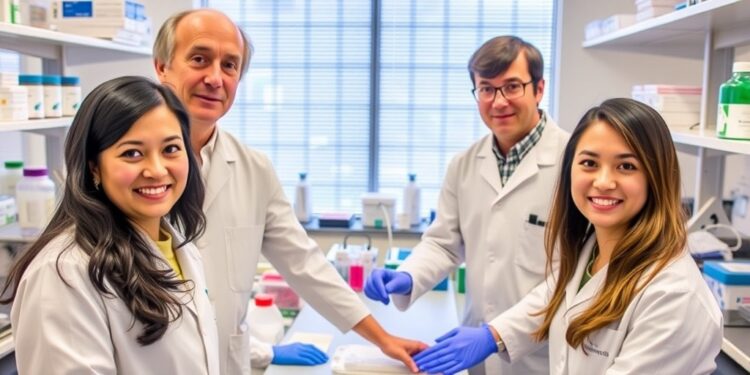
Lignans are a class of low molecular weight polyphenolic compounds that have garnered significant attention in the fields of medicine and pharmacology due to their promising antitumor and antiviral properties. These compounds are found predominantly in various plants, yet their extraction yields are often disappointingly low, compounded by the complexity of their structures. The challenges associated with isolating these compounds from plants, alongside the difficulties encountered in chemical synthesis, have hampered sustainable production methods, causing a scarcity that fails to meet the increasing market demand.
In a groundbreaking study documented in the journal Nature Chemical Biology, a team led by Professor Zhou Yongjin from the Dalian Institute of Chemical Physics, in collaboration with Professors Zhang Lei and Chen Wansheng from the Naval Medical University, has successfully achieved the biosynthesis of lignan glycoside, a notable antiviral molecule, using the yeast Saccharomyces cerevisiae. This development represents a significant leap forward in biotechnological applications, offering a biocompatible route to producing valuable compounds previously relegated to difficult and inefficient extraction or chemical synthesis processes.
The research team innovatively constructed a synthetic yeast consortium that emulates plant metabolic processes. By carefully replicating the spatial and temporal regulation found in plant biosynthesis, they created a novel system characterized by what they termed “obligated mutualism.” This design enables the yeast strains within the consortium to engage in a metabolic division of labor, ensuring that resources are utilized efficiently and effectively towards the production of the targeted compound.
One of the core challenges the team faced was the side reactions that could arise due to the broad substrate spectrum of 4-coumarate: CoA ligase. To tackle this issue, they engineered their system to minimize these undesirable side reactions, ultimately enhancing the metabolic flux directed towards lignan glycoside. This innovative strategy signifies a major step in resolving issues related to metabolic network promiscuity and provides insight into designing more yield-efficient biosynthetic pathways.
As part of their approach, the researchers developed two auxotrophic yeast strains, met15Δ and ade2Δ, which formed a mutually beneficial relationship. Through this relationship, the strains were able to cross-feed essential metabolites while simultaneously dividing the biosynthetic pathway into distinct upstream and downstream processes. This ingenuity allowed the team to execute the de novo synthesis of lariciresinol diglucoside, a lignan compound, via an impressive series of over 40 enzymatic reactions.
The implications of this research extend far beyond just the production of lignans. Professor Zhou emphasized that the cooperation between these auxotrophic strains embodies the potential for yeast communities to synthesize complex active ingredients that have traditionally been sourced from medicinal plants. This foundational work paves the way for designing cooperative yeast cell systems that could undertake an array of complex bioengineering challenges, including the synthesis of other valuable metabolites and pharmaceuticals.
Moreover, the successful implementation of this biosynthetic pathway illustrates the significant potential of synthetic biology in addressing current challenges faced in natural product chemistry. The ability to harness S. cerevisiae, a well-characterized organism in molecular biology and genetics, underscores the practical applications of synthetic yeast consortia in generating compounds that are currently challenging to obtain through natural means.
The implications of this research are vast and multifaceted, showcasing the fusion of biological engineering and natural product synthesis. With the recombinant capabilities of S. cerevisiae, researchers can potentially scale up the production of lignans, providing renewable access to these compounds for further pharmaceutical development. The transition from reliance on slow extraction processes to the rapid synthesis in engineered yeast aligns with the global push for sustainable biotechnology solutions in medicine and agriculture.
While the study primarily focused on lignans, the authors suggest that this synthetic mutualism strategy could be adapted for a range of biochemicals, heralding a new era of synthetic biology where complex natural products can be synthesized efficiently and sustainably. As the world grapples with increasing health crises and a rising demand for effective antiviral agents, this research signals a hopeful shift towards innovative biomanufacturing solutions.
Furthermore, this breakthrough may spark further research into understanding the dynamics of yeast consortia and their ability to interact symbiotically, creating new avenues for genetic engineering that may enhance not only the yield of pharmaceuticals but also the understanding of microbial ecology and the interconnectedness of biological systems. The future of medical biotechnology could be revolutionized by such collaborative approaches, leveraging the inherent properties of microorganisms to enhance production efficiency and sustainability in drug development.
In conclusion, the innovative work by Professor Zhou and his colleagues marks a pivotal advancement in the field of synthetic biology. By mimicking plant biosynthesis in yeast, they have opened new doors for the sustainable production of valuable plant-derived compounds, thus contributing crucially to both our scientific understanding and practical therapeutic applications. This research not only highlights the potential of microbial systems in bioproduction but also emphasizes the importance of innovative collaborative strategies to achieve complex biochemical syntheses in a world increasingly in need of sustainable solutions.
Subject of Research: Antiviral biosynthesis of lignan glycoside in yeast.
Article Title: De novo biosynthesis of plant lignans by synthetic yeast consortia.
News Publication Date: 17-Mar-2025.
Web References: https://doi.org/10.1038/s41589-025-01861-z
References: Nature Chemical Biology.
Image Credits: Dalian Institute of Chemical Physics.
Keywords
– Lignans
– Synthetic Biology
– Yeast Metabolism
– Antiviral Compounds
– Bioproduction
– Mutualism
– Bioengineering
Tags: antiviral properties of lignansbiotechnological applications of yeastchallenges in lignan extractioninnovative biosynthesis techniqueslow molecular weight polyphenolicsmedicinal plant compoundsmetabolic engineering in plantsNature Chemical Biology researchplant lignans biosynthesisSaccharomyces cerevisiae applicationssustainable production of phytochemicalssynthetic yeast consortia





